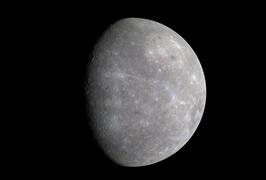MERCURY
|
Mercury is the closest planet to the Sun. It is a dense rocky world covered in craters, mountains, and ancient lava plains, like the Earth’s Moon. Because it spins so slowly, its day lasts twice as long as its year. Since it has almost no atmosphere, it has the largest temperature swings of any planet. Days are hot enough to melt lead, and nights are cold enough to freeze alcohol. The largest feature on Mercury is the Caloris Basin, a huge impact crater larger than the Gulf of Mexico!
|

